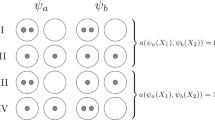Abstract
Clustering stability methods are a family of widely used model selection techniques for data clustering. Their unifying theme is that an appropriate model should result in a clustering which is robust with respect to various kinds of perturbations. Despite their relative success, not much is known theoretically on why or when do they work, or even what kind of assumptions they make in choosing an ‘appropriate’ model. Moreover, recent theoretical work has shown that they might ‘break down’ for large enough samples. In this paper, we focus on the behavior of clustering stability using k-means clustering. Our main technical result is an exact characterization of the distribution to which suitably scaled measures of instability converge, based on a sample drawn from any distribution in ℝn satisfying mild regularity conditions. From this, we can show that clustering stability does not ‘break down’ even for arbitrarily large samples, at least for the k-means framework. Moreover, it allows us to identify the factors which eventually determine the behavior of clustering stability. This leads to some basic observations about what kind of assumptions are made when using these methods. While often reasonable, these assumptions might also lead to unexpected consequences.
Article PDF
Similar content being viewed by others
Explore related subjects
Discover the latest articles and news from researchers in related subjects, suggested using machine learning.Avoid common mistakes on your manuscript.
References
Anthony, M., & Bartlet, P. (1999). Neural network learning: theoretical foundations. Cambridge: Cambridge University Press.
Ben-David, S., & von Luxburg, U. (2008). Relating clustering stability to properties of cluster boundaries. In 21st annual conference on learning theory, Helsinki, Finland, July 9–12, 2008 (pp. 379–390)
Ben-David, S., von Luxburg, U., & Pál, D. (2006). A sober look at clustering stability. In 19th annual conference on learning theory, Pittsburgh, PA, USA, June 22–25, 2006 (pp. 5–19).
Ben-David, S., Pál, D., & Simon, H.-U. (2007). Stability of k-means clustering. In 20th annual conference on learning theory, San Diego, CA, USA, June 13–15, 2007 (pp. 20–34).
Ben-Hur, A., Elisseeff, A., & Guyon, I. (2002). A stability based method for discovering structure in clustered data. In Pacific symposium on biocomputing, Lihue, Hawaii, USA, January 3–7, 2002 (pp. 6–17).
Bertoni, A., & Valentini, G. (2007). Model order selection for biomolecular data clustering. BMC Bioinformatics, 8(Suppl 2), S7.
Duda, R. O., Hart, P. E., & Stork, D. G. (2001). Pattern classification (2nd edn.). New York: Wiley.
Dudley, R. (1999). Uniform central limit theorems. Cambridge studies in advanced mathematics. Cambridge: Cambridge University Press.
Dudoit, S., & Fridlyand, J. (2002). A prediction-based resampling method for estimating the number of clusters in a dataset. Genome Biology, 3(7), 0036.1–0036.21.
Hartigan, J. (1975). Clustering algorithms. New York: Wiley.
Hoeffman-Jørgensen, J., Shepp, L. A., & Dudley, R. (1979). On the lower tail of gaussian seminorms. The Annals of Probability, 7(2), 319–342.
Horn, R. A., & Johnson, C. R. (1985). Matrix analysis. Cambridge: Cambridge University Press.
Krieger, A., & Green, P. (1999). A cautionary note on using internal cross validation to select the number of clusters. Psychometrika, 64(3), 341–353.
Lange, T., Roth, V., Braun, M. L., & Buhmann, J. M. (2004). Stability-based validation of clustering solutions. Neural Computation, 16(6), 1299–1323.
Latała, R., & Oleszkiewicz, K. (1999). Gaussian measures of dilatations of convex symmetric sets. Annals of Probability, 27(4), 1922–1938.
Levine, E., & Domany, E. (2001). Resampling method for unsupervised estimation of cluster validity. Neural Computation, 13(11), 2573–2593.
Linder, T. (2002). Principles of nonparametric learning. In L. Gyorfi (Ed.), CISM courses and lecture notes : Vol. 434. Learning-theoretic methods in vector quantization. New York: Springer. Chap. 4.
Milman, V. D., & Schechtman, G. (1986). Asymptotic theory of finite dimensional normed spaces. Berlin: Springer.
Pollard, D. (1982). A central limit theorem for k-means clustering. The Annals of Probability, 10(4), 919–926.
Radchenko, P. (2004). Asymptotics under nonstandard conditions. PhD thesis, Yale University.
Shamir, O., & Tishby, N. (2008a). Cluster stability for finite samples. In J. C. Platt, D. Koller, Y. Singer, & S. Roweis (Eds.), Advances in neural information processing systems (Vol. 20, pp. 1297–1304). Cambridge: MIT Press.
Shamir, O., & Tishby, N. (2008b). Model selection and stability in k-means clustering. In 21st annual conference on learning theory, Helsinki, Finland, July 9–12, 2008 (pp. 367–378). Cambridge: MIT Press.
Shamir, O., & Tishby, N. (2009). On the reliability of clustering stability in the large sample regime. In D. Koller, D. Schuurmans, Y. Bengio, & L. Bottou (Eds.), Advances in neural information processing systems (Vol. 21, pp. 1465–1472). Cambridge: MIT Press.
Smolkin, M., & Ghosh, D. (2003). Cluster stability scores for microarray data in cancer studies. BMC Bioinformatics, 4, 36.
Steinley, D. (2006). K-means clustering: a half-century synthesis. British Journal of Mathematical & Statistical Psychology, 59(1), 1–34.
van der Vaart, A. W., & Wellner, J. A. (1996). Weak convergence and empirical processes: with applications to statistics. Berlin: Springer.
Author information
Authors and Affiliations
Corresponding author
Additional information
Editors: Sham Kakade and Ping Li.
Rights and permissions
About this article
Cite this article
Shamir, O., Tishby, N. Stability and model selection in k-means clustering. Mach Learn 80, 213–243 (2010). https://doi.org/10.1007/s10994-010-5177-8
Received:
Accepted:
Published:
Issue Date:
DOI: https://doi.org/10.1007/s10994-010-5177-8




